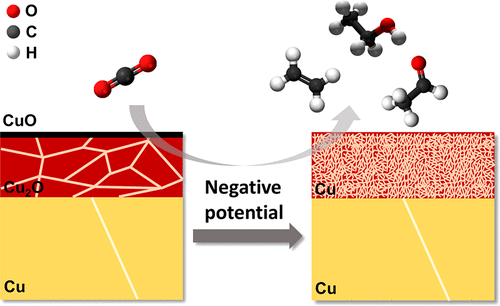

 Oxide-/hydroxide-derived copper electrodes exhibit excellent selectivity toward C2+ products during the electrocatalytic CO2 reduction reaction (CO2RR). However, the origin of such enhanced selectivity remains controversial. Here, we prepared two Cu-based electrodes with mixed oxidation states, namely, HQ-Cu (containing Cu, Cu2O, CuO) and AN-Cu (containing Cu, Cu(OH)2). We extracted an ultrathin specimen from the electrodes using a focused ion beam to investigate the distribution and evolution of various Cu species by electron microscopy and electron energy loss spectroscopy. We found that at the steady stage of the CO2RR, the electrodes have all been reduced to Cu0, regardless of the initial states, suggesting that the high C2+ selectivities are not associated with specific oxidation states of Cu. We verified this conclusion by control experiments in which HQ-Cu and AN-Cu were pretreated to fully reduce oxides/hydroxides to Cu0, and the pretreated electrodes showed even higher C2+ selectivity compared with their unpretreated counterparts. We observed that the oxide/hydroxide crystals in HQ-Cu and AN-Cu were fragmented into nanosized irregular Cu grains under the applied negative potentials. Such a fragmentation process, which is the consequence of an oxidation–reduction cycle and does not occur in electropolished Cu, not only built an intricate network of grain boundaries but also exposed a variety of high-index facets. These two features greatly facilitated the C–C coupling, thus accounting for the enhanced C2+ selectivity. Our work demonstrates that the use of advanced characterization techniques enables investigating the structural and chemical states of electrodes in unprecedented detail to gain new insights into a widely studied system.
Oxide-/hydroxide-derived copper electrodes exhibit excellent selectivity toward C2+ products during the electrocatalytic CO2 reduction reaction (CO2RR). However, the origin of such enhanced selectivity remains controversial. Here, we prepared two Cu-based electrodes with mixed oxidation states, namely, HQ-Cu (containing Cu, Cu2O, CuO) and AN-Cu (containing Cu, Cu(OH)2). We extracted an ultrathin specimen from the electrodes using a focused ion beam to investigate the distribution and evolution of various Cu species by electron microscopy and electron energy loss spectroscopy. We found that at the steady stage of the CO2RR, the electrodes have all been reduced to Cu0, regardless of the initial states, suggesting that the high C2+ selectivities are not associated with specific oxidation states of Cu. We verified this conclusion by control experiments in which HQ-Cu and AN-Cu were pretreated to fully reduce oxides/hydroxides to Cu0, and the pretreated electrodes showed even higher C2+ selectivity compared with their unpretreated counterparts. We observed that the oxide/hydroxide crystals in HQ-Cu and AN-Cu were fragmented into nanosized irregular Cu grains under the applied negative potentials. Such a fragmentation process, which is the consequence of an oxidation–reduction cycle and does not occur in electropolished Cu, not only built an intricate network of grain boundaries but also exposed a variety of high-index facets. These two features greatly facilitated the C–C coupling, thus accounting for the enhanced C2+ selectivity. Our work demonstrates that the use of advanced characterization techniques enables investigating the structural and chemical states of electrodes in unprecedented detail to gain new insights into a widely studied system.